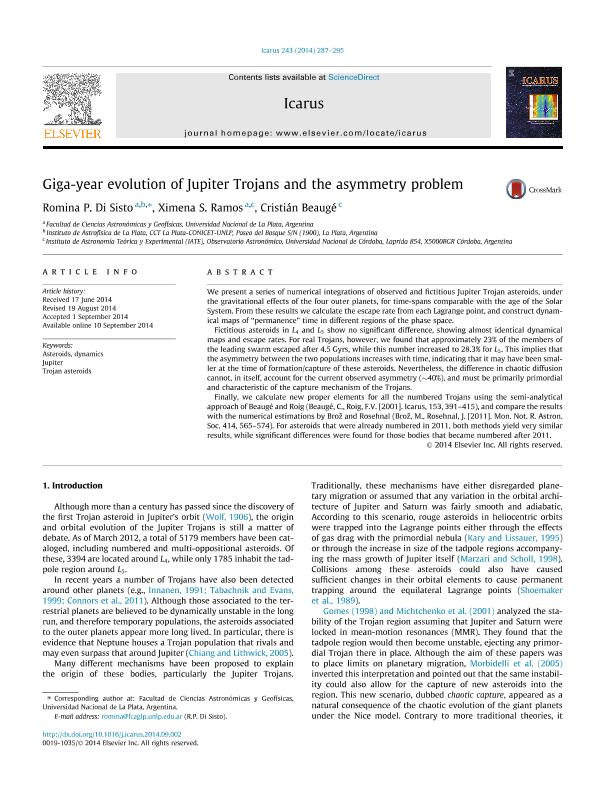Artículo
Giga-year evolution of Jupiter Trojans and the asymmetry problem
Fecha de publicación:
09/2014
Editorial:
Elsevier Inc
Revista:
Icarus
ISSN:
0019-1035
Idioma:
Inglés
Tipo de recurso:
Artículo publicado
Clasificación temática:
Resumen
We present a series of numerical integrations of observed and fictitious Jupiter Trojan asteroids, under the gravitational effects of the four outer planets, for time-spans comparable with the age of the Solar System. From these results we calculate the escape rate from each Lagrange point, and construct dynamical maps of ‘‘permanence’’ time in different regions of the phase space. Fictitious asteroids in L4 and L5 show no significant difference, showing almost identical dynamical maps and escape rates. For real Trojans, however, we found that approximately 23% of the members of the leading swarm escaped after 4.5 Gyrs, while this number increased to 28.3% for L5. This implies that the asymmetry between the two populations increases with time, indicating that it may have been smaller at the time of formation/capture of these asteroids. Nevertheless, the difference in chaotic diffusion cannot, in itself, account for the current observed asymmetry (40%), and must be primarily primordial and characteristic of the capture mechanism of the Trojans. Finally, we calculate new proper elements for all the numbered Trojans using the semi-analytical approach of Beaugé and Roig (Beaugé, C., Roig, F.V. [2001]. Icarus, 153, 391–415), and compare the results with the numerical estimations by Brozˇ and Rosehnal (Brozˇ, M., Rosehnal, J. [2011]. Mon. Not. R. Astron. Soc. 414, 565–574). For asteroids that were already numbered in 2011, both methods yield very similar results, while significant differences were found for those bodies that became numbered after 2011.
Palabras clave:
Asteroids
,
Dynamics
,
Jupiter
,
Trojan Asteroids
Archivos asociados
Licencia
Identificadores
Colecciones
Articulos(IALP)
Articulos de INST.DE ASTROFISICA LA PLATA
Articulos de INST.DE ASTROFISICA LA PLATA
Articulos(IATE)
Articulos de INST.DE ASTRONOMIA TEORICA Y EXPERIMENTAL
Articulos de INST.DE ASTRONOMIA TEORICA Y EXPERIMENTAL
Citación
Beauge, Cristian; Ramos, Ximena Soledad; Di Sisto, Romina Paula; Giga-year evolution of Jupiter Trojans and the asymmetry problem; Elsevier Inc; Icarus; 243; 9-2014; 287-295
Compartir
Altmétricas




